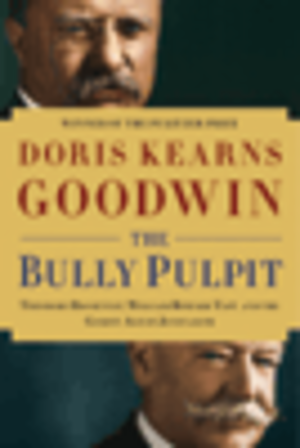The Bully Pulpit: Theodore Roosevelt and the Golden Age of Journalism by Doris Kearns Goodwin
Book review: The Bully Pulpit, by Doris Kearns GoodwinDoris Kearns Goodwin tells the story of America's Progressive Era through the relationship between Theodore Roosevelt and William Howard Taft


The Bully Pulpit: Theodore Roosevelt and the Golden Age of Journalism
By Doris Kearns Goodwin
Published by Viking (Buy at Amazon
Subscribe to MoneyWeek
Subscribe to MoneyWeek today and get your first six magazine issues absolutely FREE

Sign up to Money Morning
Don't miss the latest investment and personal finances news, market analysis, plus money-saving tips with our free twice-daily newsletter
Don't miss the latest investment and personal finances news, market analysis, plus money-saving tips with our free twice-daily newsletter
)
A widening gulf between rich and poor, corporate malfeasance at every turn and the corrupting influence of money on politics. Despite the obvious parallels, it's not a description of our times, but of the United States at the beginning of the 20th century, when growing public anger brought about the period of wide-ranging reforms known as the Progressive Era. In The Bully Pulpit, acclaimed biographer and historian Doris Kearns Goodwin reviews this tumultuous spell through the story of the friendship-turned-enmity between reformist president Theodore Roosevelt and his less-acclaimed successor William Howard Taft.
The book is an "ambitious undertaking", says Bill Keller in The New York Times. Besides the two presidents, there is "a colourful cast of industrialists, labour leaders, political rivals, cabinet members and, especially, fired-up journalists". But the author captures "her characters with precision and affection", while "the story comes together like a well-wrought novel". It's like watching "The West Wing scripted by Henry James".
"Goodwin's evocative examination of the Progressive world is smart and engaging," agrees Professor Heather Cox Richardson of Boston College, writing in The Washington Post. In telling the story, the author borrows effectively from the crusading journalists who helped shape the politics of the day. "Her style shows her imitating the amassing of evidence pioneered by the muckrakers." It is a "highly readable and detailed portrait of an era", which "brings the early 20th century to life and firmly establishes the crucial importance of the press to Progressive politics".
The book took Kearns eight years to write and produce and "the effort shows, much to the reader's benefit and delight", says Erik Spanberg, writing for CSMonitor.com. Having covered other American leaders, including Abraham Lincoln and John F. Kennedy, the writer clearly "has a knack for finding fresh angles to bring her beloved dead presidents back to life". She manages to "keep the story clipping along" she chooses "enlightening anecdotes and has the narrative and historical acumen to weave her theme through 900 pages".
There are a few minor criticisms. The book is very readable, but Goodwin's "discussion of muckraking goes on far too long, distracting from the main story", says John Steele Gordon in The Wall Street Journal. And there's "the occasional sense that this in fact might be two books, rather than one", says The Economist. But in all it is a "sophisticated, character-driven" book and certainly "timely".
The Bully Pulpit: Theodore Roosevelt and the Golden Age of Journalism by Doris Kearns Goodwin is published by Viking (£20).
Matthew graduated from the University of Durham in 2004; he then gained an MSc, followed by a PhD at the London School of Economics.
He has previously written for a wide range of publications, including the Guardian and the Economist, and also helped to run a newsletter on terrorism. He has spent time at Lehman Brothers, Citigroup and the consultancy Lombard Street Research.
Matthew is the author of Superinvestors: Lessons from the greatest investors in history, published by Harriman House, which has been translated into several languages. His second book, Investing Explained: The Accessible Guide to Building an Investment Portfolio, is published by Kogan Page.
As senior writer, he writes the shares and politics & economics pages, as well as weekly Blowing It and Great Frauds in History columns He also writes a fortnightly reviews page and trading tips, as well as regular cover stories and multi-page investment focus features.
Follow Matthew on Twitter: @DrMatthewPartri
-
 Private school fees soar and VAT threat looms – what does it mean for you?
Private school fees soar and VAT threat looms – what does it mean for you?Rising private school fees could see more than one in five parents pull their children out of their current school. Before you remortgage, move house or look to grandparents for help, here’s what you need to know.
By Katie Williams Published
-
 Best and worst UK banks for online banking revealed
Best and worst UK banks for online banking revealedWhen it comes to keeping your money safe, not all banks are equal. We reveal the best and worst banks for online banking when it comes to protecting your money from scams
By Oojal Dhanjal Published
